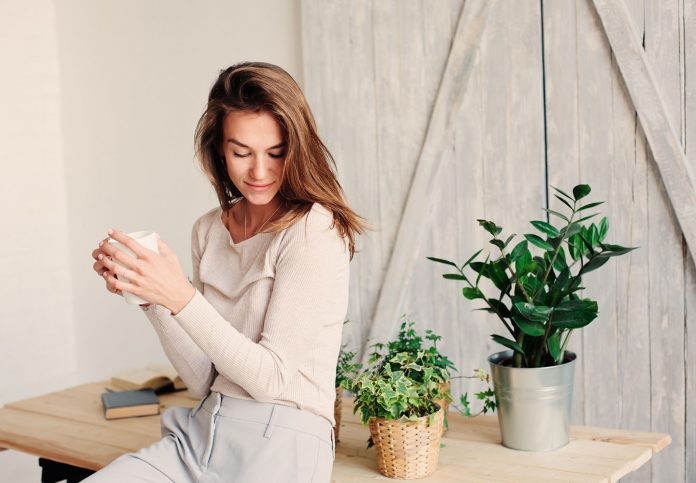Display meaningful objects
The process of letting go of “stuff” doesn’t mean you should live in a stark environment—Dr. Augustin says this would feel alien to us. Kondo’s method uses the test of whether an object “sparks joy” in your heart. “When you decide what to keep based on what sparks joy, you are establishing and reaffirming to yourself what is most important to you,” she says. It’s not about the latest home design styles—it’s how an object makes you feel. Still love showing off that soccer trophy from third grade? Keep it! As far as how much to display, balance out the chaos in your life with a visually quieter environment. The amount that feels right may vary from person to person, but Dr. Augustin suggests four or five pictures in a room and a couple of objects on a surface, depending on the size. Kondo says an added benefit of going through your possessions is learning how to get rid of mental baggage as well as the physical. “The skills you learn can be applied in your life well beyond deciding on which souvenir coffee mug to keep,” she says.
Show your personality
When deciding how a room should look, you might feel taken in by the cool new design trend you saw in a magazine or on HGTV. But Dr. Augustin says making sure your house aligns with your personality is key to feeling happy in your space. “People who are extroverted get a real charge out of the world around them, so they can enjoy a more sensorially rich environment,” she says. “People who are more introverted have a richer inner world so they should have a more carefully curated space.” Bolder patterns and colors might stimulate extroverts but overwhelm introverts. A study from Switzerland shows that introverts were more sensitive to visual stimuli than extroverts, so they should have a more relaxing set-up. “Introverts do a much better job at processing the sensory information around them than extroverts do,” Dr. Augustin says. “Introverts perceive it all and extroverts perceive only some of it,” so they can handle more
Create a calming space
Finding a “sanctuary” in your home gives your mind a place to go to rest and restore, helping you feel more at peace. It doesn’t have to be a whole room—it could be a reading nook, a knitting or craft space, or even a “home spa” in your bathroom. In carving out your sacred space, Dr. Augustin suggests bright but muted colors like sage, soft textures like flannel, warm light, and curved lines in patterns and objects instead of straight lines. Studies show we prefer curved lines because we see sharp transitions, such as right angles, as more of a threat. Avoid these other hidden sources of stress you didn’t know you had.
Bring nature inside
Studies have shown nature to be calming to our psyche, so one way to feel happier in your space is to bring in plants or flowers. “Bringing nature into your home definitely has powerful psychological effects,” says interior designer Rebecca West, also a design psychology coach. “Peace lilies are one of my favorites because they’re easy-care and do well in low light conditions.” Dr. Augustin also suggests avoiding spiky plants. “We associate comfort with curvy shapes and not spiky ones, which make us more alert,” she says. Houseplants have the added benefit of helping to refresh the air in a room, making you healthier, according to research. “But if you aren’t blessed with a green thumb, then fresh flowers or even a print of a garden or a wall mural of trees can affect some of that same profound healing,” West says. “Even having natural wood furniture in your home partnered with green accessories or wall paint can bring that outdoor feeling inside.”
Use light well
Psychologists have long known that light has an effect on our emotions. So when choosing what kind of light to have in your home, think about what feelings you’re trying to elicit in the space. “Warm light with warm light bulbs is better for when you’re socializing and relaxing, where blue and cooler light is better when you’re trying to do a really analytic task,” Dr. Augustin says. So cool light might be better for a home office, but use warm light in the living and dining rooms. “When people are having dinner parties they bring in candles, which are a warmer light—something we figured out eons ago which aligns with modern research,” she says. During the day, open the curtains and keep the windows clean to let the sun in. “Natural light is great for our mood,” Dr. Augustin says. “But if a space is really glare-y because you have lots of shiny surfaces, some of these positive ramifications of daylight evaporate because glare is stressful.”
Keep it clean
Having a clean home can have physical as well as mental benefits—less stuff means fewer things for dust and dirt to accumulate on, and you’ll be more likely to keep it clean because it won’t be so overwhelming. “The less clutter there is in your home, the easier it is to do basic cleaning chores, which let’s be honest, spark joy in almost nobody!” Kondo says. Instead, you can use the time you save to do other things you enjoy more. But sometimes, a good cleaning can actually help you feel less stressed and anxious, as a British study found. “If you find yourself feeling frantic and overwhelmed, taking a moment to tidy up the kitchen or your bed can really calm those nerves and bring more focus into your mind,” West says.































